2. 重庆市气象科学研究所, 重庆 401147;
3. 中国科学院大气物理研究所大气科学和地球流体力学数值模拟国家重点实验室(LASG), 北京 100029;
4. 中国气象局气象干部培训学院, 北京 100081
2. Chongqing Institute of Meteorological Sciences, Chongqing 401147;
3. State Key Laboratory of Numerical Modeling for Atmospheric Sciences and Geophysical Fluid Dynamics, Institute of Atmospheric Physics, Chinese Academy of Sciences, Beijing 100029;
4. China Meteorological Administration Training Centre, Beijing 100081
东亚是典型的季风气候影响区。一般来说,季风是指近地面层盛行风向接近相反且气候特征明显不同的现象(朱乾根等,2007)。Ramage(1971)总结前人的研究工作,更加明确地指出盛行风向的平均频率要超过40%。20世纪30年代,Zhu(1934)和Tu et al.(1937)就利用地面和对流层低层盛行气流,表示了各月季风的一般活动情况。随后,陶诗言(1948)和高由禧(1948)用更多的地面风观测资料和高空探测风记录,得到了东亚季风平均进退和结构的一般概念。这些研究表明,地面风的研究是季风研究的一个重要方面。
东亚夏季风在20 世纪表现出在多种时间尺度上都有很大变率(Zhou et al., 2009a)。针对20世纪70年代中期东亚夏季风表现出的年代际减弱,已有大量研究(Chang et al., 2000;Wang,2001;郭其蕴等,2004; Yu et al., 2004; Yu and Zhou, 2007; Zhou et al. 2008; Li et al. 2010)。青藏高原作为平均高度 3000米的抬高热源,对维持东亚夏季风环流起着重要作用(Flohn,1957;叶笃正等,1979;Zhao et al., 2007)。因此,青藏高原热源变化与东亚季 风之间的关系一直以来就是研究的热点之一。最近,Boos and Kuang(2010)就对青藏高原的热力作用和动力作用进行了比较,引起了古季风和近代季风研究界的重视。Wu et al.(2012)通过数值实验研究表明,青藏高原如同巨大的“感热气泵”,使得东亚季风和南亚季风东部受青藏高原热力强迫的影响非常显著。朱玉祥等(2007,2009)研究则表明,高原冬春积雪偏多, 高原大气春夏季热源偏弱。高由禧等(1962)认为,季风现象是海陆分布、大气环流和具体地形等3种因素错综影响下的综合现象。青藏高原位于东亚季风区,夏季其上空大气为热源,对亚洲大气环流演变具有极其重要的影响(叶笃正等,1957)。由于春季高原积雪对亚洲夏季风有着重要的影响,研究表明,积雪的增加会明显减弱亚洲夏季风的强度(郑益群等,2000);包庆等(2008)通过数值模拟研究认为,青藏高原增暖可能是导致东亚夏季风年代际变化的重要因子之一;Duan and Wu(2005)、Wu et al.(2007)通过观测资料分析,认为青藏高原加热可以导致东亚季风的加强。所以,用春季积雪来解释东亚夏季风的年代际变化原因,具有很好的合理性。
上述研究大都是针对对流层低层的季风风速而进行,而关于地面风盛行风向频率的研究,近30余年来很少;而且关于东亚夏季风在年代际时间尺度的变化研究,也主要是针对20世纪70年代中期发生的年代际跃变而进行。Liu et al.(2012)研究表明,东亚夏季风自20世纪90年代初开始出现恢复加强之趋势。高由禧等(1962)认为,在我国南方和东南沿海地区盛夏(7月和8月)期间,东南季风和西南季风交替出现最为显著,而且由于水汽来源的不同,东南季风和西南季风对我国夏季降水影响的分布也有一定的差异(竺可桢,1934;乔云亭等,2002)。因此,有必要进一步将东亚季风划分为东南季风和西南季风,在此基础上,研究其频率在近30余年来的变化和成因,显得非常重要。
2 资料和方法
所用资料包括:
(1)中国气象局国家气象信息中心提供的中国756站一日4次地面风观测值和中国160站逐月降水资料,时间跨度为1979~2011年。
(2)中国气象局国家气象信息中心提供的逐日台站雪深资料。其时间跨度为1979~2010年,这些台站主要分布于高原东部地区(朱玉祥,2007,2009)。参照朱玉祥等,2007,2009选取高原积雪厚度指数的方法,定义无缺测值的50个台站雪深的平均值做为高原积雪强度,并将之标准化后定义为积雪厚度指数(SDI)。文中的春季指3、4月平均。
(3)NCEP/NCAR再分析资料(Kalnay et al., 1996),其中包括925 hPa的风场,500 hPa位势高度场以及200 hPa温度场。由于NCEP/NCAR再分析资料在20世纪70年代中后期的年代际变化有一定的争议(Inoue and Matsumoto,2004),故以上所有资料都从1979年开始。
方法:
Mann-Kendall(M-K)作为一种非参数统计检验方法,在气候趋势变化研究中被广泛应用。其基本原理是:对于具有n个样本量的时间序列![]() ,构建一秩序列:
,构建一秩序列:

(1)式中,当![]() 时,
时,![]() ;当
;当![]() 时,
时,![]()
![]() 。
。
在时间序列随机独立的假定下,定义统计量为:

式中,![]() 是累计量
是累计量![]() 的方差和均值,在
的方差和均值,在![]() 相互独立,且有相同连续分布时,可由下式算出:
相互独立,且有相同连续分布时,可由下式算出:

UFi为标准正态分布,是按时间序列![]() 计算出的统计量序列,给定显著性水平a,若|UFi|>a,则表明序列有明显的趋势变化。按时间序列x逆序xn, …, x2, x1,再重复上述过程,同时使UFk=-UBk (k=n, n-1, …, 1), UF1=0。分析绘出的UFk,UBk曲线,当UFk或者UBk的值大于0,则表明序列呈上升趋势,小于0则表明呈下降趋势。当UFk或UBk的值超过临界线时,表明上升或下降趋势显著。如果UFk,UBk两条曲线出现交点,且交点在临界线之间,那么交点对应的值便是突变开始的时间(符淙斌和王强,1992)。文中使用的其它统计方法还有相关分析、统计t检验等方法。
计算出的统计量序列,给定显著性水平a,若|UFi|>a,则表明序列有明显的趋势变化。按时间序列x逆序xn, …, x2, x1,再重复上述过程,同时使UFk=-UBk (k=n, n-1, …, 1), UF1=0。分析绘出的UFk,UBk曲线,当UFk或者UBk的值大于0,则表明序列呈上升趋势,小于0则表明呈下降趋势。当UFk或UBk的值超过临界线时,表明上升或下降趋势显著。如果UFk,UBk两条曲线出现交点,且交点在临界线之间,那么交点对应的值便是突变开始的时间(符淙斌和王强,1992)。文中使用的其它统计方法还有相关分析、统计t检验等方法。
3 结果分析 3.1 东亚盛夏季风频率的定义
东亚夏季风可分为东南季风和西南季风(高由禧等,1962)。根据地面资料中风向观测的方法,风向一般用16个方位表示(张霭琛,2000)。定义东东南、东南和南东南风为东南季风;定义西西南、西南和南西南风为西南季风。参考文献Zhang et al. (1996),Wu and Ni(1997),Liu et al.(2012)关于东亚季风选取的范围,选取20°~30°N,110°~125°E为东南季风和西南季风的研究区域。东亚东南季风与西南季风的频率以该区域范围内、1979年以来无缺测值的93个台站的地面风场资料(图 1)来计算。文中盛夏指7、8月平均。
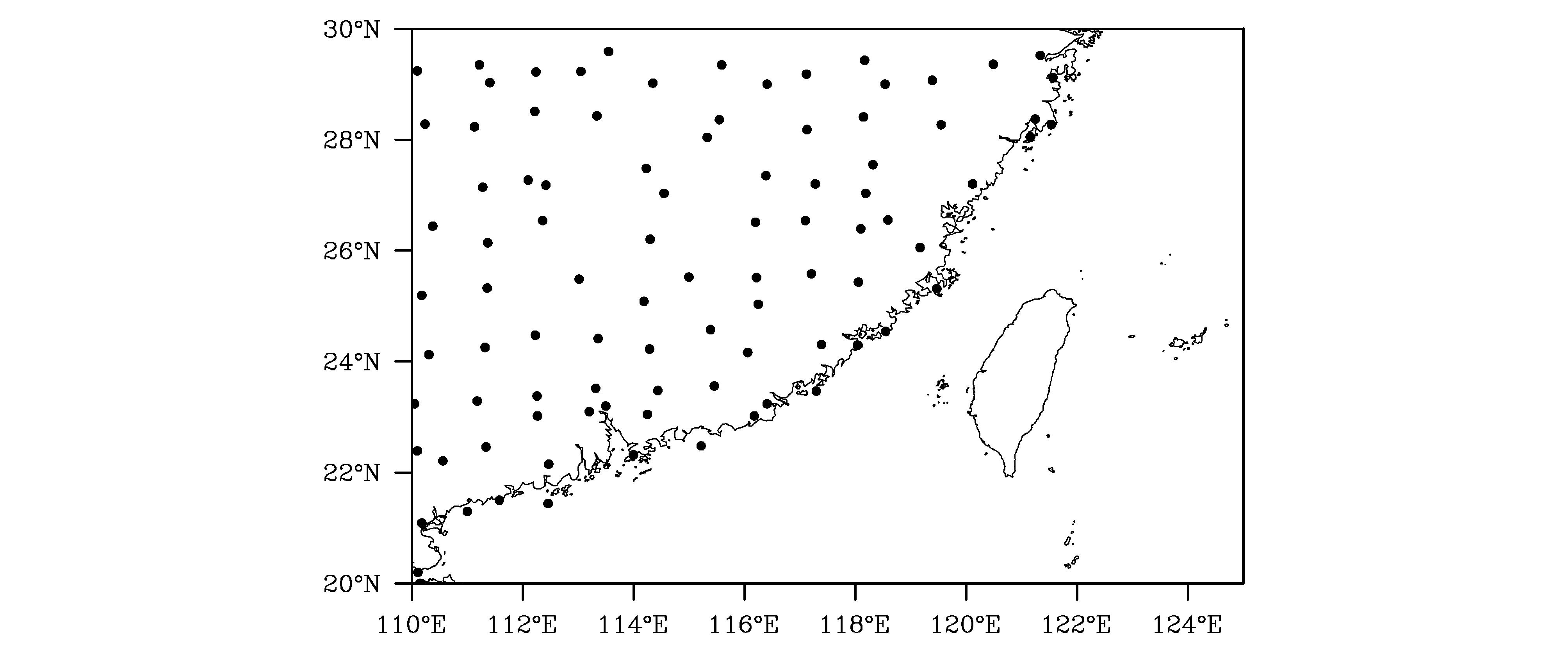 |
图 1 长江以南93个站点分布 Fig. 1 Distribution of the 93 stations in south of the Yangtze River of China |
东南(西南)季风频率![]() (
(![]() )可分别表示为:
)可分别表示为:

其中,
将![]() 和
和![]() 标准化后,定义为东南季风和西南季风频率指数。
标准化后,定义为东南季风和西南季风频率指数。
图 2给出了1979年以来标准化后的盛夏东南季风(虚线)和西南季风(实线)频率指数的时 间序列。由图可见,30多年来,东南(西南)季 风频率有明显的年际变化和年代际变化特征,在2000年以前,时间序列主要表现为波动形式,但是大致在2000年以后,两者都有一个显著的上升趋势。
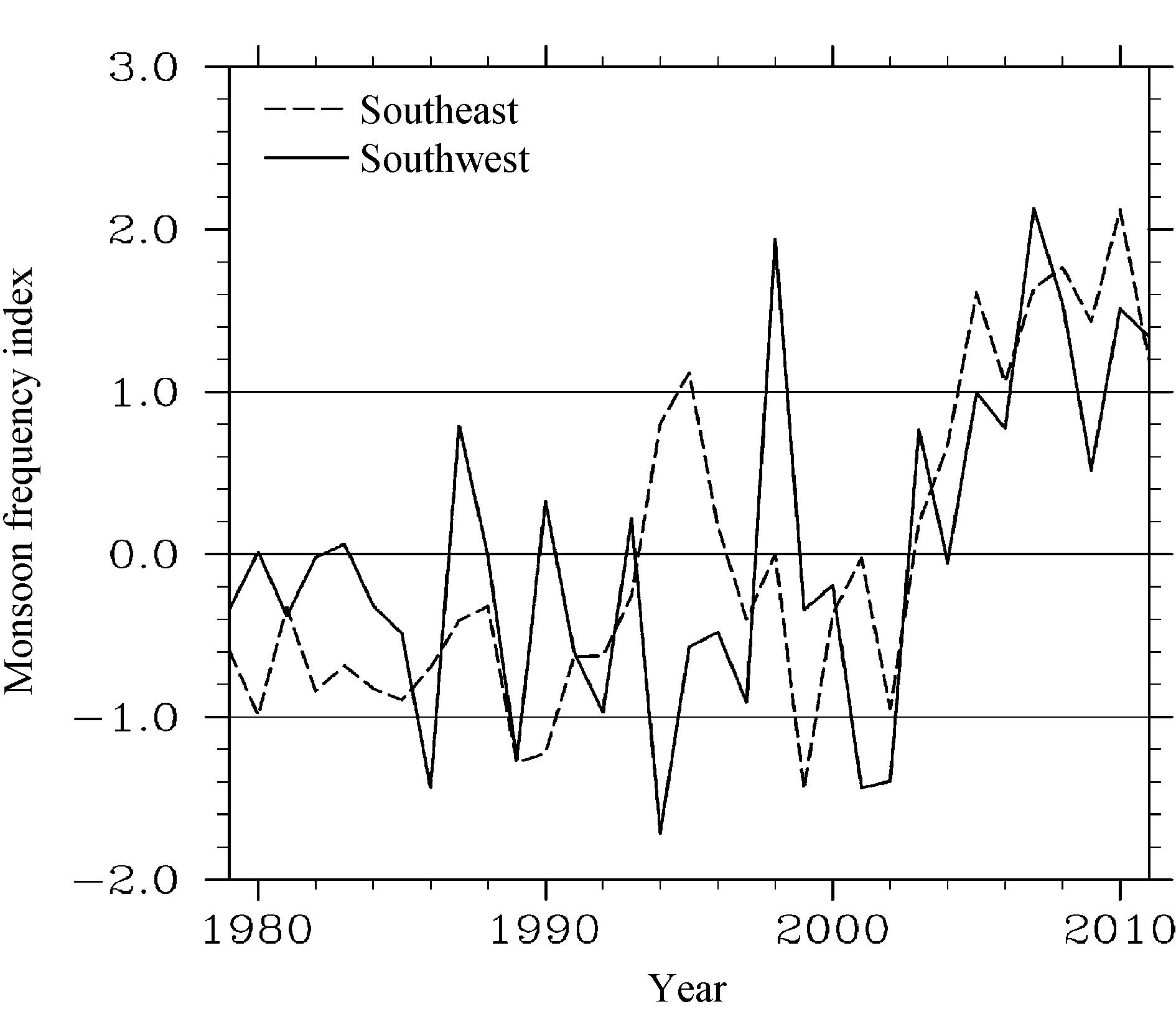 |
图 2 东亚盛夏东南季风频率指数和西南季风频率指数时间序列 Fig. 2 Time series of southeast monsoon frequency index and southwest monsoon frequency index in East Asia in JA (July-August) |
3.2 东亚东南季风和西南季风频率与中国160站盛夏降水的年际关系
一个好的季风指数,既要能够刻画季风环流的变化,又要能够描述季风降水的特征(郭其蕴等,1983;Goswami et al., 1999)。为检验东南季风和西南季风频率指数定义的合理性,图 3分别给出了盛夏东南季风频率指数和西南季风频率指数与同期中国160站降水的相关系数分布。由图 3a可见,整个华北至山东半岛为正值,而江南及华南地区为负值,显著的正相关区域主要位于我国黄河以南至山东半岛附近,这个结果和竺可桢(1934)所指出的夏季我国东南季风强盛时,长江流域主旱,华北主涝的结论基本一致,这也说明了所选取的东南季风频率指数具有很好的合理性。
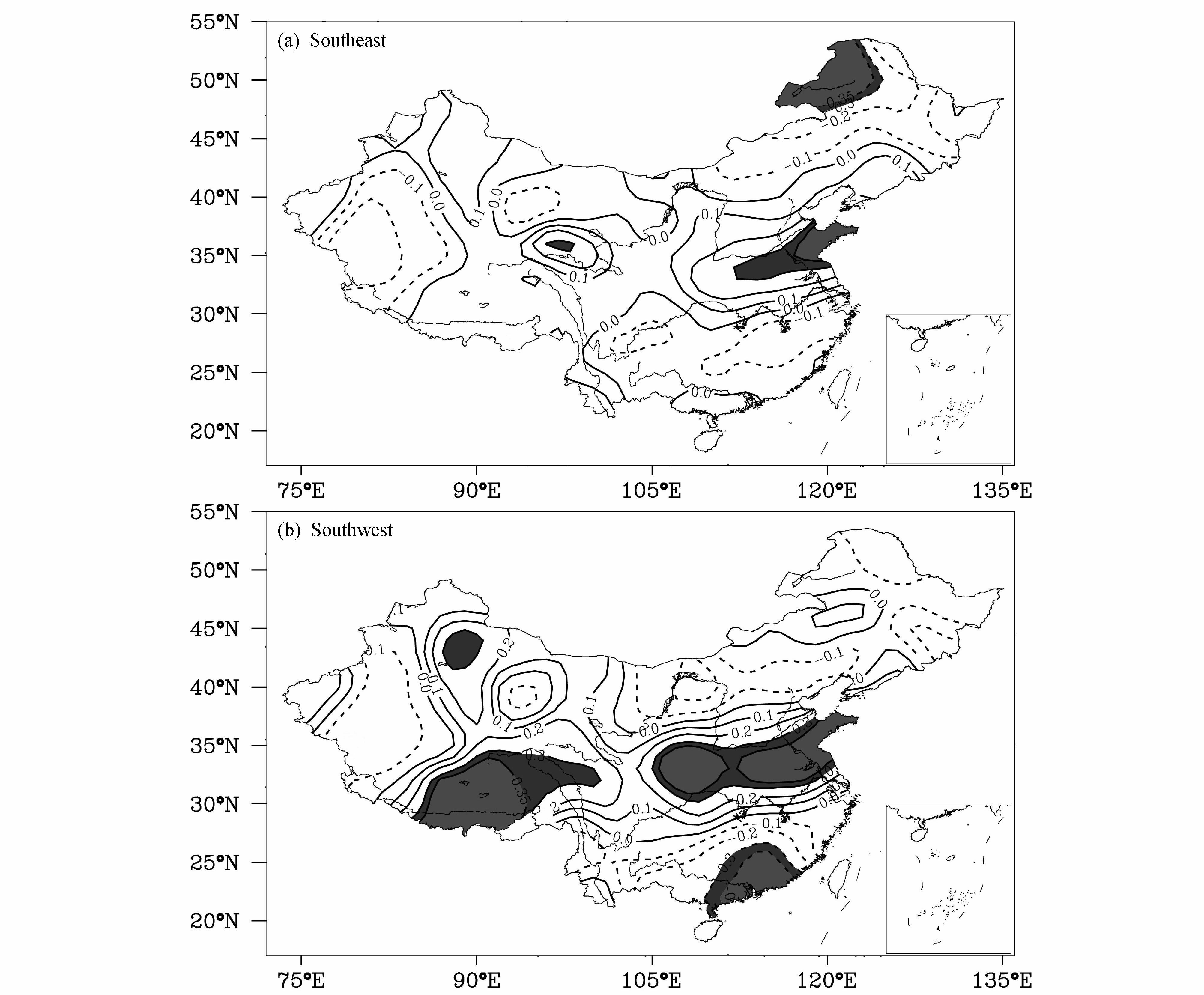 |
图 3 季风频率指数和我国盛夏160站降水的同期相关分布:(a)东南季风频率指数;(b)西南季风频率指数。阴影区表示通过95%的信度检验 Fig. 3 Correlation coefficient between summer monsoon frequency index and rainfall at 160 stations in JA: (a) Southeast monsoon; (b) southwest monsoon. Shaded areas are statistically significant at the 95% confidence level according to Student’s t-test |
图 3b和图 3a相比,相关系数分布图则有所不同。尽管相关系数分布在我国东部地区从南到北也呈“-+-”三极型分布(Zhou and Yu, 2005;黄荣辉等,2011),但是显著的正相关区主要分布在黄河流域和江淮地区(30°~35°N、105°~120°E),在华南沿海地区则呈显著的负相关,说明当西南季风增强时,黄河流域与淮河流域之间地区降水异常偏多,而华南地区降水则异常偏少。
3.3 东亚盛夏东南季风频率与西南季风频率的年代际变化
此前关于东亚夏季风年代际变化的研究,多关注发生在20世纪70年代末的季风减弱现象(Zhou et al., 2009a; 宇如聪等,2008; Li et al. 2010)。有证据表明,近30余年来,季风亦呈现出年代际的变化特征(Liu et al., 2012)。为检验两种季风频率的年代际变化,分别对1979~2011年盛夏东南季风频率和西南季风频率指数作了M-K检验(图 4)。可见,东南季风频率跃变点发生在2003年左右,西南季风频率的年代际跃变点发生在2005年左右。为了进一步验证东南(西南)季风频率突变点的准确性,又分别对其年代际变化进行了差值t检验,得出的t统计量分别为8.33、5.05,均通过了99.9% 的信度检验。因此,无论是东南季风频率还是西 南季风频率,均在21世纪初期发生了明显的年代际跃变,而且两者都发生了由少变多的年代际增加趋势。
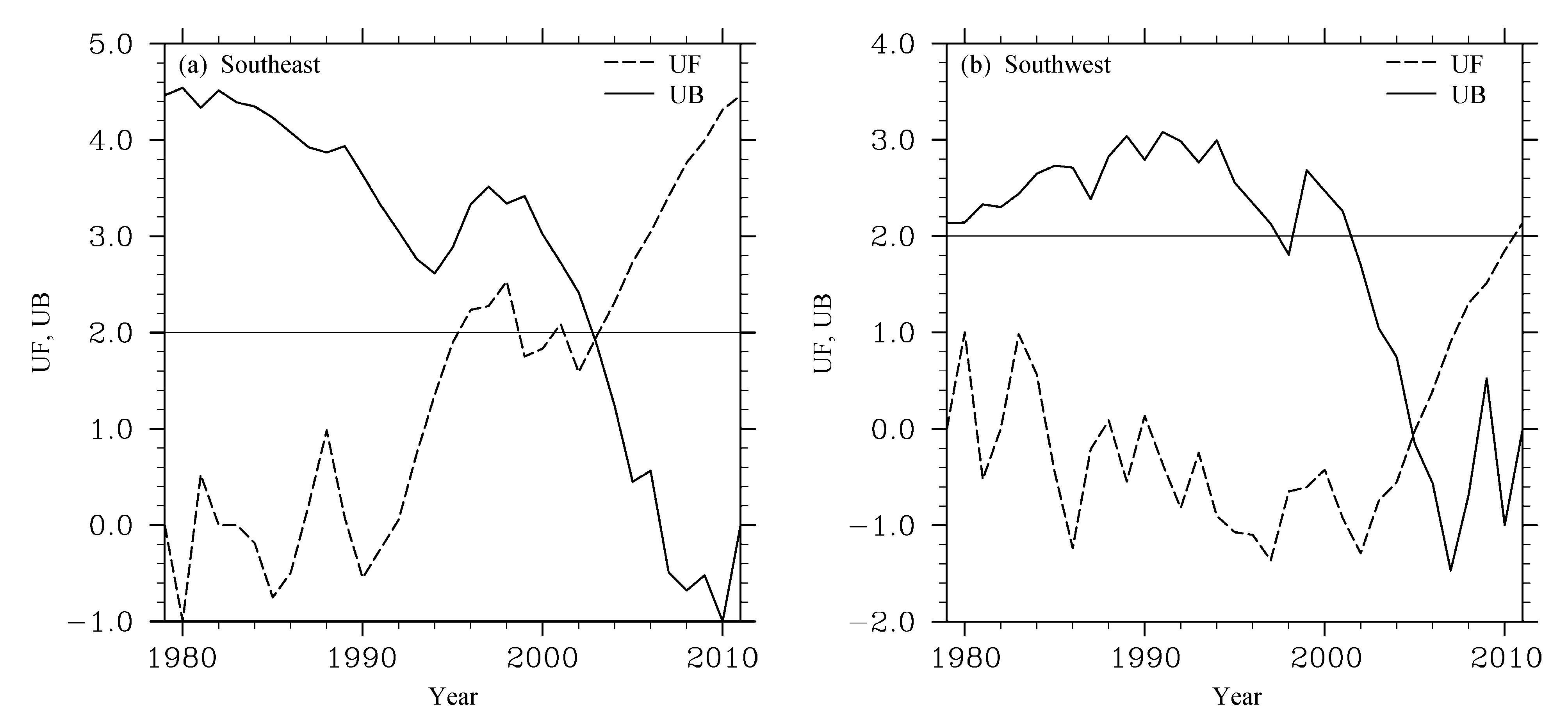 |
图 4 季风频率指数的M-K检验(实横线表示95%信度水平):(a)东南季风频率指数;(b)西南季风频率指数 Fig. 4 Mann-Kendall test of monsoon frequency index (the solid horizontal lines denote 95% confidence level): (a) Southeast monsoon; (b) southwest monsoon |
3.4 中国东部盛夏降水的年代际变化
上述研究表明,东南季风和西南季风频率和中国东部地区盛夏降水有很大的关系。既然东南季风和西南季风频率在21世纪初期以后均发生了年代际增多,那么中国东部地区盛夏降水是否也发生了年代际跃变。为此,为了进行统一对比,以2003年为界,给出了2003~2011年平均与1979~2002年平均的盛夏中国160站降水差值图(图 5),并进行了差值t检验。由图 5可见,中国东部盛夏降 水由南到北也呈“-+-”三极型分布。华北地区、黄淮以及江淮地区(30°~35°N,105°~123°E)均为正距平,其中在淮河地区增加最为显著,说明自2003年以后,淮河流域降水显著增加。需要强调指出的是,这和伴随东亚夏季风在20世纪70年代中期以后减弱出现的“南涝北旱”有明显不同(Hu,1997;宇如聪等,2008)。因此,中国东部盛夏降水自21世纪初期以来,出现了向淮河流域以北地区北移的年代际变化特征,Zhu et al. (2011) 也揭示了类似的降水变化特征。
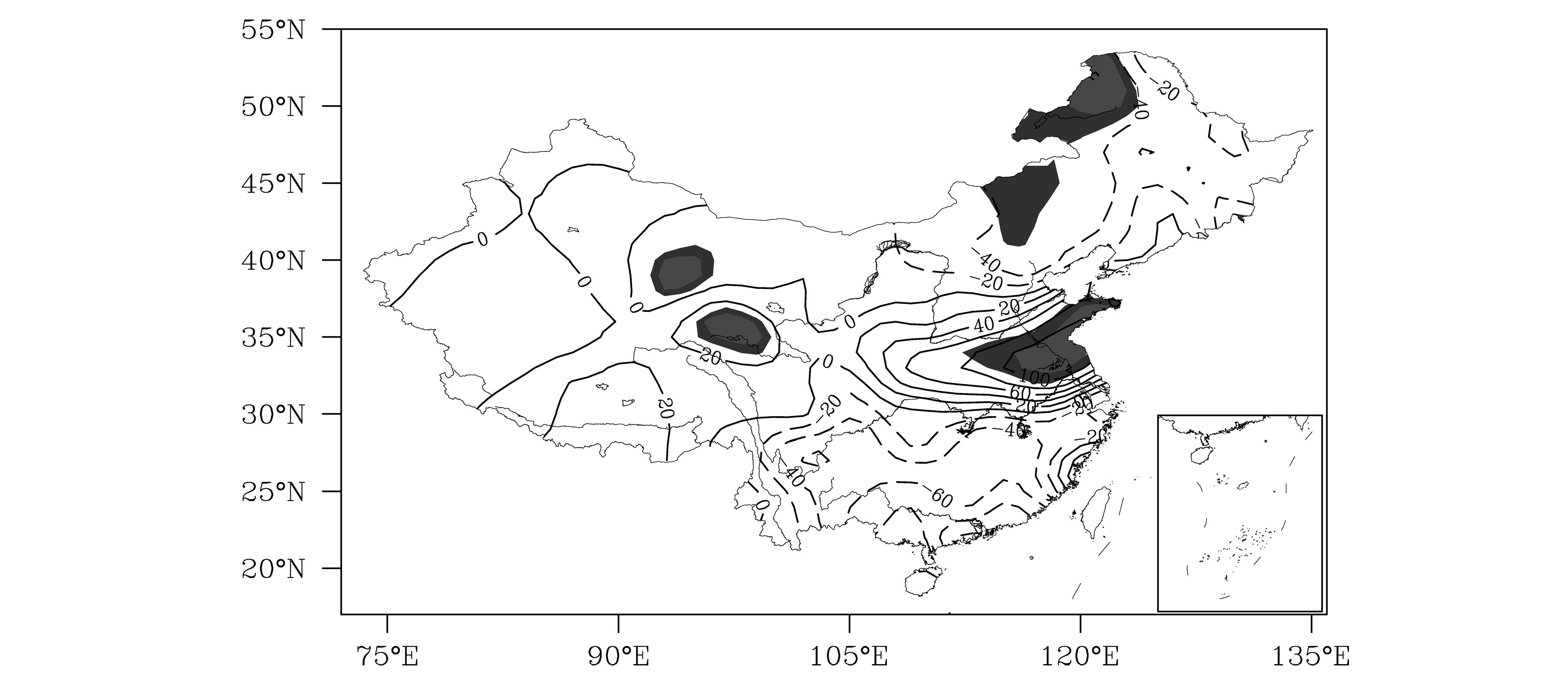 |
图 5 2003~2011年平均与1979~2002年平均盛夏中国160站降水量差(单位:mm)。阴影区表示通过95%的信度检验 Fig. 5 Changes (2003-2011 minus 1979-2002) in JA precipitation (unit:mm) based on 160 stations in China. Shaded areas are statistically significant at the 95% confidence level according to Student’s t-test |
3.5 东亚夏季西南季风频率和东南季风频率年代 际变化与高原积雪的年代际变化之间的关系包庆等(2008)通过数值模拟研究认为,青藏高原增暖可能是导致东亚夏季风年代际变化的重要因子之一。为了揭示盛夏东南季风频率和西南季风频率的年代际变化的原因,计算了青藏高原地区地面春季积雪厚度指数(SDI)的时间序列并对其趋势变化进行了M-K检验(图 6)。由图可见,春季高原积雪除了有明显的年际变化以外,在2001年左右也发生了年代际跃变,其发生的年代际变 化年份和盛夏东亚东南季风和西南季风频率发 生的年代际变化基本一致。同样对其进行差值t检验,得出的t统计量为-2.84,通过了99%的信度检验。因此,春季高原积雪在21世纪初期发生的年代际变化,可能是盛夏东亚东南季风和西南季风频率在21世纪初期发生年代际变化的重要原因之一。
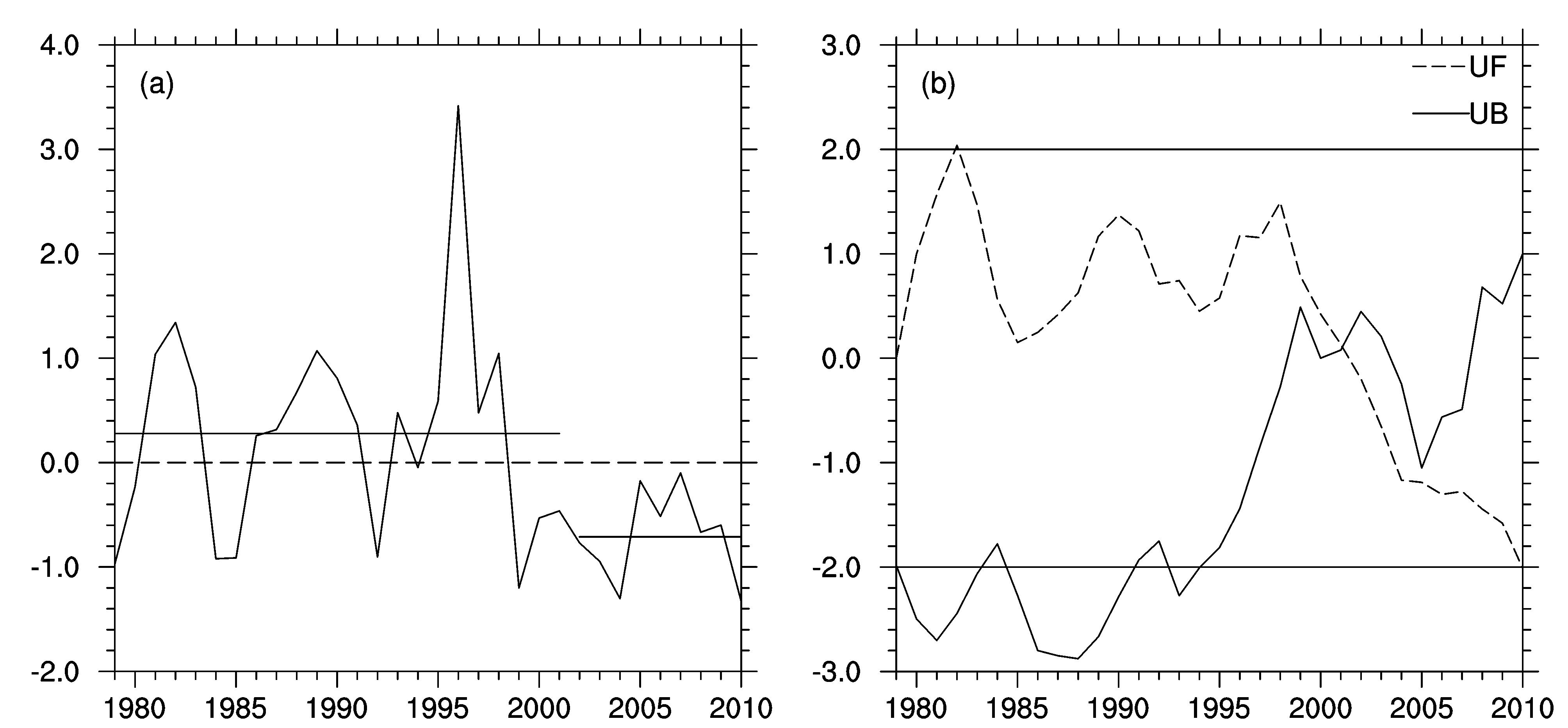 |
图 6 青藏高原积雪厚度指数(SDI)的(a)时间序列(实横线表示1979~2001年和2002~2010年SDI平均值)以及(b)M-K检验(实横线表示95%信度水平) Fig. 6 (a) Time series of SDI (snow depth index) on TP (the solid horizontal lines indicate the 1979-2001 mean and 2002−2010 mean); (b) Mann-Kendall test of SDI (the solid horizontal lines denote 95% confidence level) |
研究表明,积雪的减少使得高原表面反照率降低,对太阳辐射的吸收增加,地表温度升高,从而使青藏高原上空大气温度升高(包庆等,2008)。青藏高原变暖通过感热输送,影响上空的大气稳定度,进而影响高原上空的降水;同时,高原上空的降水又通过潜热释放,导致高原上空的南亚高压加强(Rodwell and Hoskins, 1996)。
图 7a清楚地显示出21世纪初期青藏高原出现了明显的年代际增暖。研究表明,青藏高原增暖有助于增强对流层上层的南亚高压、高原北侧西风急流和高原南侧东风急流以及印度低空西南季风、其下游对流层低层(18°~28°N,108°~118°E)反气旋性环流异常增强;东亚地区表现为对流层低层西南季风增强(包庆等,2008)。因此,由于高原变暖,使得春季高原积雪发生了显著的年代际变化,十分有利于盛夏东亚西南季风频率的增加。
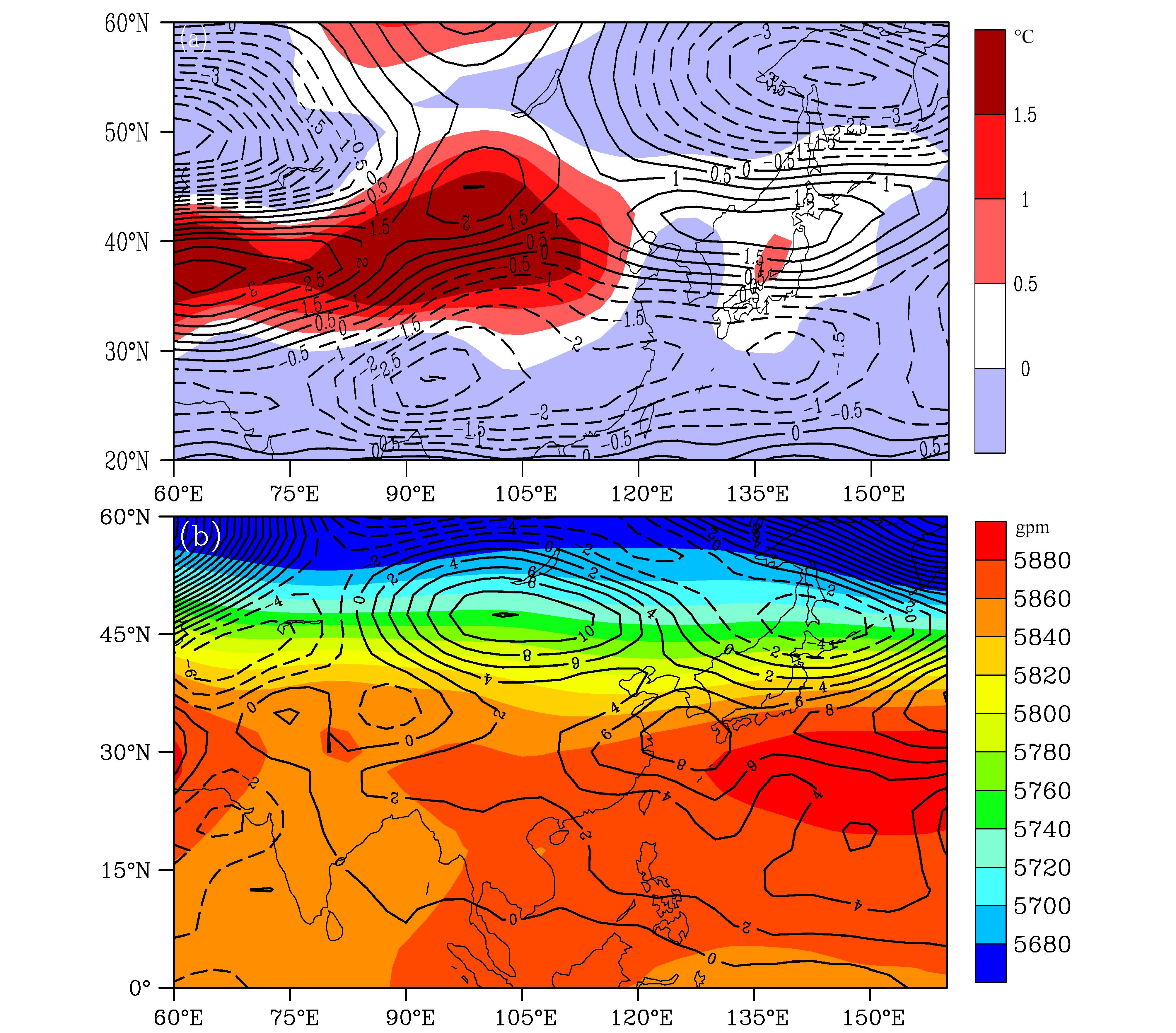 |
图 7 (a)盛夏200 hPa温度(彩色阴影,单位:°C)、纬向风(等值线,单位:m/s)的年代际变化(2003~2011年与1979~2002年平均值之差);(b)500 hPa位势高度场的年代际变化(2003~2011年与1979~2002年平均值之差)(单位:gpm),填色阴影表示500 hPa位势高度场的平均值 Fig. 7 (a) Interdecadal variation (2003-2011 minus 1979-2002) in JA upper tropospheric (200 hPa) air temperature (color shading, unit: °C), 200-hPa westerly (contours, unit: m/s); (b) interdecadal variation (2003-2011 minus 1979-2002) in JA 500-hPa geopotential height (contours, unit: gpm). Shading in Fig. 6b indicates climate mean state of JA 500-hPa geopotential height |
青藏高原增暖影响东亚季风的另一途径是通过湿反馈作用引起,即高原地表温度的改变会导致大气感热加热的改变,大气环流向感热加热的调整适应会诱发降水场的变化,从而导致大气潜热加热的改变。由于青藏高原变暖存在的这种湿反馈作用,使得高原东部产生上升运动,导致东亚地区产生更多的降水(Wang et al., 2008)。图 5表明,在中国东部淮河流域一带,盛夏降水发生了明显的年代际增多。由Sverdrup涡度平衡关系,江淮地区降水的异常增多,通过潜热释放使得副热带高压发生年代际增强(Sverdrup, 1947;Hoskins and Wang, 2006;Wang et al., 2008)。图 7b清楚地表明,在西北太平洋地区以及日本海一带有一个正距平大值区,这充分说明西太平洋副热带高压变强,而且发生了年代际北抬。
研究表明,Sverdrup 涡度平衡可以适用于副热 带高压脊线附近(Wu and Liu,2003;Liu et al., 2001),而且淮河流域降水在对流层加热变为最大 时,有利于在(20°~40°N,100°~130°E)地区对流层低层出现向极气流(Wang et al., 2008)
由Sverdrup涡度平衡关系式:

其中,
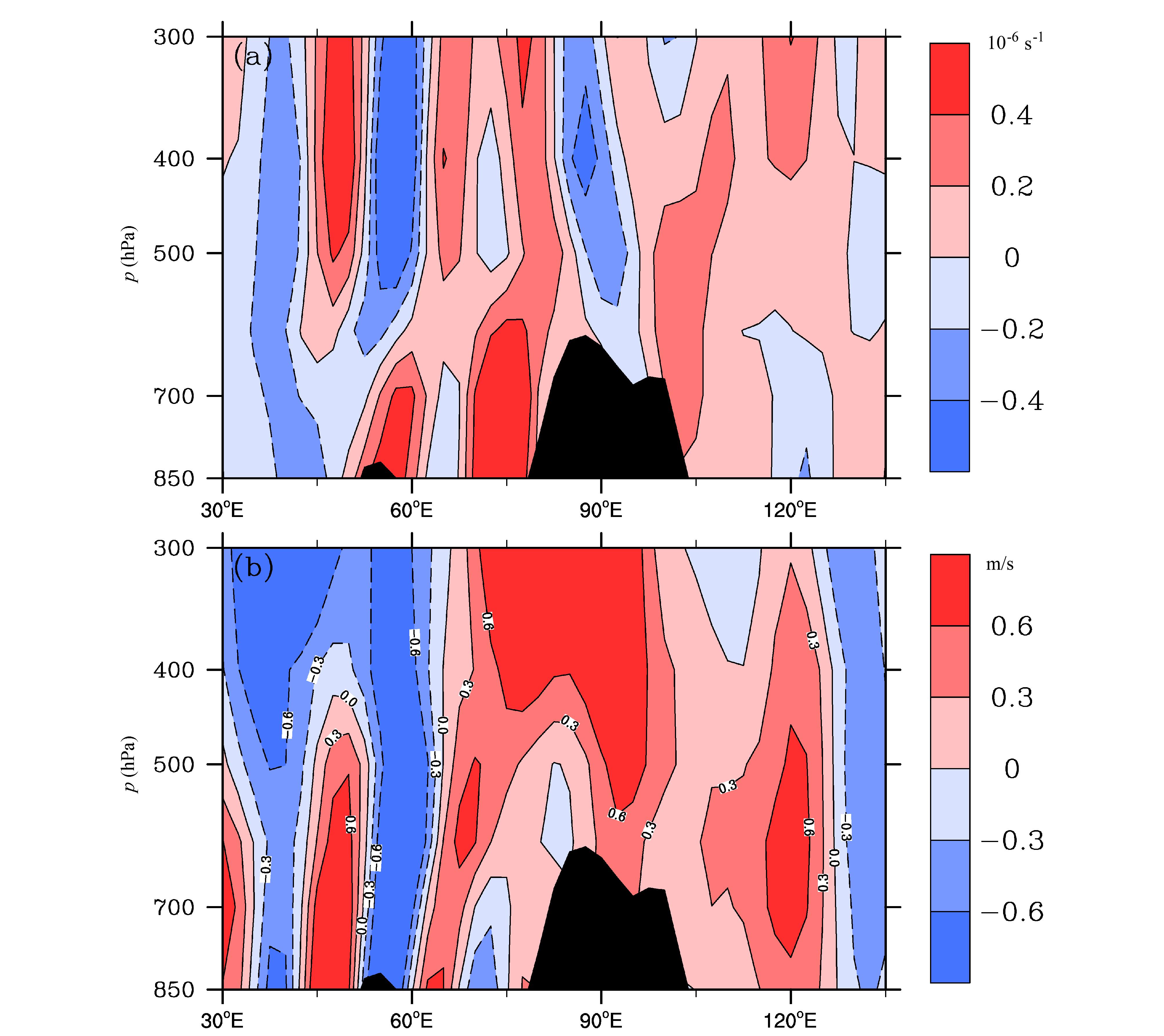 |
图 8 ((a)垂直速度梯度∂ω /∂p (单位:10-6 s-1)的年代际变化(2003~2011 年与1979~2002 年平均值之差)和(b)经向风速(单位:m/s)的 年代际变化(2003~2011 年与1979~2002 年平均值之差)的经度—高度剖面图(纬向平均取30°~40°N)。图中黑色阴影代表地形 Fig. 8 Longitude–height cross sections of interdecadal variations (2003–2011 minus 1979–2002) in (a) vertical velocity gradient ∂ω /∂p (unit: 10-6 s-1) and (b) meridional wind (unit: m/s) averaged over 30°–40°N. The terrain is shown in black shaded areas |
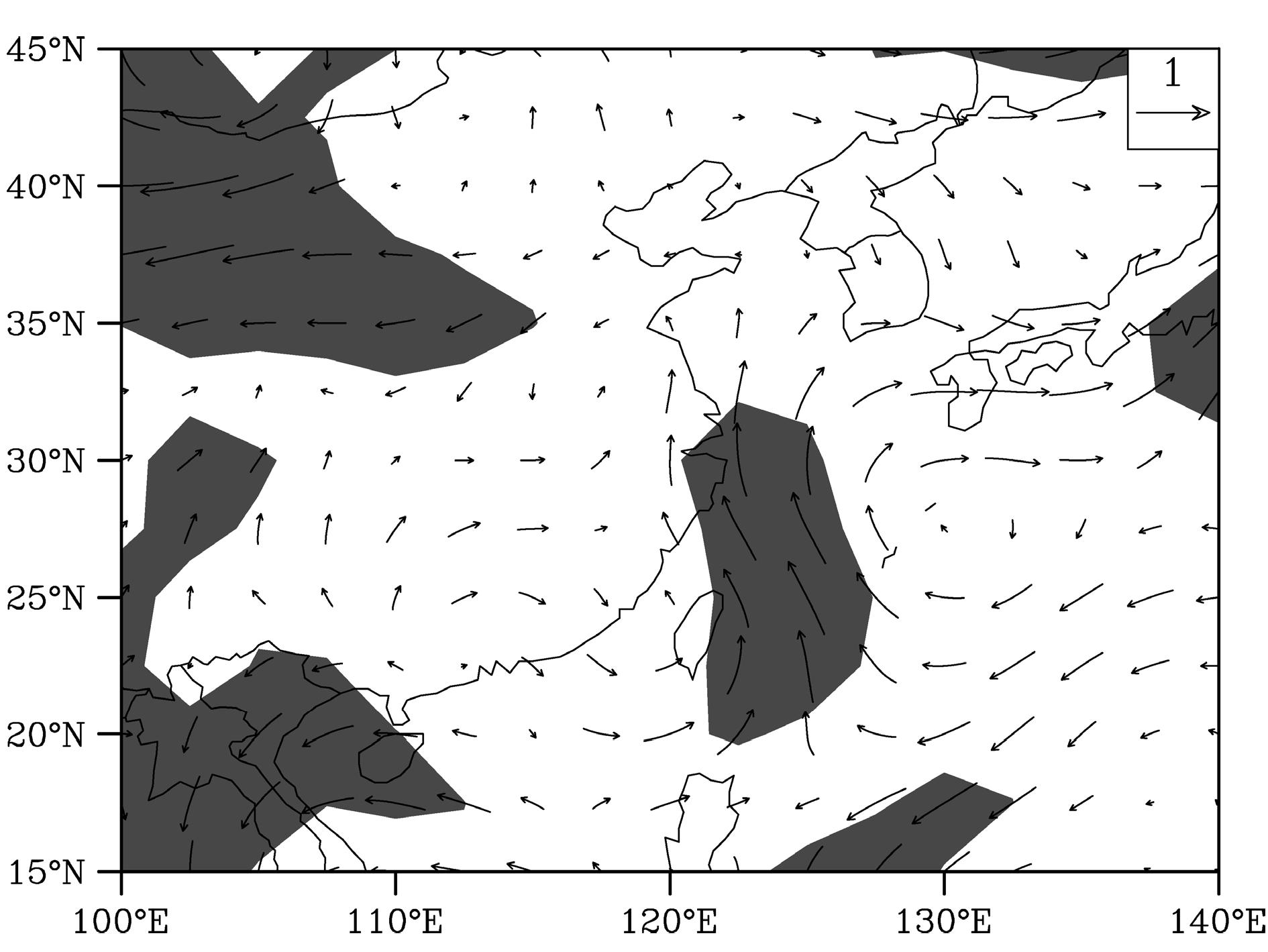 |
图 9 2003~2011年平均与1979~2002年平均盛夏925 hPa风场差(单位:m/s)。阴影区表示通过95%的信度检验 Fig. 9 Changes (2003-2011 minus 1979-2002) in JA for 925 hPa winds (unit: m/s). Shaded areas are statistically significant at the 95% confidence level according to Student’s t-test |
综上所述,图 10给出了高原积雪影响东亚西南季风和东南季风的概念模型图:由于青藏高原积雪厚度的年代际变浅,高原发生了年代际变暖,南亚高压发生了年代际增强,致使其下游对流层低层(18°~28°N,108°~118°E)反气旋性环流异常增强,东亚西南季风频率发生年代际增加;同时,由于高原发生湿反馈的作用,使得东亚地区包括江淮地区降水发生年代际变多,由Sverdrup涡度平衡关系,江淮地区降水的异常增多,通过潜热释放使得副热带高压发生年代际增强,而东亚副热带高压异常加强,则有利于盛夏东亚东南季风频率发生年代际增加。
 |
图 10 青藏高原积雪影响东亚西南季风和东南季风频率的示意图(“A”表示反气旋环流) Fig. 10 Schematic diagram showing the effect of the snow cover over the Tibetan Plateau on the southwest and southeast monsoon frequency in East Asia (A indicates the anticyclone) |
4 结论和讨论
利用地面观测资料和NCEP/NCAR再分析资料,分析了盛夏东亚东南季风和西南季风频率在年代际时间尺度上的变化特征及其可能原因,主要结论如下:
(1)盛夏东亚东南季风频率、西南季风频率 具有显著的年代际变化特征。从21世纪初期以 来,两者都发生了明显的年代际变多。伴随着盛夏东南季风和西南季风频率的年代际增多,中国东 部地区盛夏降水出现了向淮河流域北移的年代际变化。
(2)东南季风频率和西南季风频率与中国东部盛夏降水在年际时间尺度上存在显著的相关关系。尽管东南季风频率、西南季风频率和中国东部降水都呈“-+-”3极型分布,但是显著的相关中心区域有所不同。东南季风频率主要与山东半岛降水呈显著正相关关系,表明东南季风频率对盛夏山东半岛降水有显著的影响;西南季风频率显著的正相关区域主要位于淮河流域(30°~35°N,105°~120°E),显著的负相关中心则位于中国华南地区,表明西南季风频率越多,盛夏江淮河流域降水越多,而华南地区盛夏降水则越少。
(3)东南季风和西南季风频率在21世纪初期以后发生的年代际增加,和青藏高原春季积雪厚度的年代际变化有关。由于青藏高原积雪的厚度发生了年代际变浅,表明青藏高原发生了年代际变暖。青藏高原发生的年代际变暖,它一方面有利于南亚高压的增强,使得其下游对流层低层(18°~28°N,108°~118°E)反气旋性环流异常增强,有利于东亚西南季风频率发生年代际增多;另一方面,由于高原发生湿反馈作用,使得江淮地区降水发生年代际变多, 根据Sverdrup涡度平衡关系,江淮地区降水的异常增多,通过潜热释放使得副热带高压发生年代际增强,东亚副热带高压异常加强,有利于盛夏东亚东南季风频率发生年代际增加。
需要指出的是,本文仅从地面东南季风和西南季风频率的角度,揭示了盛夏东亚夏季风偏南季风频率发生了年代际变化的观测事实。在此基础上,从前期春季高原积雪变化的角度,对地面东南季风和西南季风频率发生年代际变化的原因进行了解释。而关于前期春季高原积雪厚度影响夏季东亚季风的机制,已有大量的数值模拟结果进行了验证(包庆等,2008;Wang et al., 2008)。这些数值模拟结果,支持了本文基于观测事实而提出的高原积雪影响季风频率变化的机制。同时,春季高原积雪与高原上空大气热源之间发生的年代际变化,以及它们影响东亚夏季风发生的年代际变强之间的关系,我们将在随后的研究中作进一步的分析和研究。
| [1] | 包庆, Wang Bin, 刘屹岷, 等. 2008. 青藏高原增暖对东亚夏季风的影响——大气环流模式数值模拟研究[J]. 大气科学, 32 (5): 997-1005. Bao Qing, Wang Bin, Liu Yimin, et al. 2008. The impact of the Tibetan Plateau warming on the East Asian summer monsoon—A study of numerical simulation[J]. Chinese Journal of Atmospheric Sciences (in Chinese), 32 (5): 997-1005. |
| [2] | Boos W R, Kuang Z M. 2010. Dominant control of the South Asian monsoon by orographic insulation versus plateau heating[J]. Nature, 463: 218-222. |
| [3] | Chang C P, Zhang Y S, Li T. 2000. Interannual and interdecadal variations of the East Asian summer monsoon and tropical Pacific SSTs. PartⅠ: Roles of the subtropical ridge[J]. J. Climate, 13: 4310-4325. |
| [4] | Duan A M, Wu G X. 2005. Role of the Tibetan Plateau thermal forcing in the summer climate patterns over subtropical Asia[J]. Climate Dyn., 24: 783-807. |
| [5] | 符淙斌, 王强. 1992. 气候突变的定义和检测方法[J]. 大气科学, 16 (4): 482-493. Fu Congbin, Wang Qiang. 1992. The definition and detection of the abrupt climatic change[J]. Chinese Journal of Atmospheric Sciences (in Chinese), 16 (4): 482-493. |
| [6] | Flohn H. 1957. Large-scale aspects of the "summer monsoon" in South and East Asia[C]// South and East Asia. J. Meteor. Soc. Japan 75th Ann Vol. 180-186. |
| [7] | 高由禧. 1948. 东亚自由大气之运行[J]. 气象研究所集刊, 16 (1): 1-15. Gao Youxi. 1948. The running of free atmosphere in East Asian[J]. Memoir of the National Research Institute of Meteorology, Academia Sinica (in Chinese), 16 (1): 1-15. |
| [8] | 高由禧, 徐淑英, 郭其蕴, 等. 1962. 东亚季风若干问题[M]. 北京: 科学出版社, 12-27. Gao Youxi, Xu Shuying, Guo Qiyun, et al. 1962. Some Problems about East Asian Monsoon (in Chinese)[M]. Beijing: Science Press, 12-27. |
| [9] | 郭其蕴. 1983. 东亚夏季风强度指数及其变化的分析[J]. 地理学报, 38 (3): 207-217. Guo Qiyun. 1983. The summer monsoon intensity index in East Asia and its variation[J]. Acta Geographica Sinica (in Chinese), 38 (3): 207-217. |
| [10] | 郭其蕴, 蔡静宁, 邵雪梅, 等. 2004. 1873-2000年东亚夏季风变化的研究[J]. 大气科学, 28 (2): 206-215. Guo Qiyun, Cai Jingning, Shao Xuemei, et al. 2004. Studies on the variations of East-Asian summer monsoon during AD 1873-2000[J]. Journal of Atmospheric Sciences (in Chinese), 28 (2): 206-215. |
| [11] | Goswami B N, Krishnamurthy V, Annamalai H. 1999. A broad-scale circulation index for the interannual variability of the Indian summer monsoon[J]. Quart. J. Roy. Meteor. Soc., 125: 611-633. |
| [12] | Hoskins B, Wang B. 2006. Large-scale atmospheric dynamics[C]//Wang B. The Asian Monsoon. New York: Springer, 357-415. |
| [13] | Hu Z Z. 1997. Interdecadal variability of summer climate over East Asia and its association with 500 hPa height and global sea surface temperature[J]. J. Geophys. Res., 102: 19403-19412. |
| [14] | 黄荣辉, 陈际龙, 刘永. 2011. 我国东部夏季降水异常主模态的年代际变化及其与东亚水汽输送的关系[J]. 大气科学, 35 (4): 589-606. Huang Ronghui, Chen Jilong, Liu Yong. 2011. Interdecadal variation of the leading modes of summertime precipitation anomalies over eastern China and its association with water vapor transport over East Asia[J]. Chinese Journal of Atmospheric Sciences (in Chinese), 35 (4): 589-606. |
| [15] | Inoue T, Matsumoto J. 2004. A comparison of summer sea level pressure over East Eurasia between NCEP/NCAR reanalysis and ERA-40 for the period 1960-99[J]. J. Meteor. Soc. Japan, 82(3): 951-958. |
| [16] | Kalnay E, Kanamitsu M, Kistler R, et al. 1996. The NCEP/NCAR 40-year reanalysis project[J]. Bull. Amer. Meteor. Soc., 77: 437-471. |
| [17] | Li H M, Dai A G, Zhou T J, et al. 2010. Responses of East Asian summer monsoon to historical SST and atmospheric forcing during 1950-2000[J]. Climate Dyn., 34: 501-514, doi:10.1007/s00382-008-0482-7. |
| [18] | Liu H W, Zhou T J, Zhu Y X, et al. 2012. The Strengthening East Asia summer monsoon since the early 1990s[J]. Chinese Sci. Bull., 57 (13): 1553-1558. |
| [19] | Liu Y M, Wu G X, Liu H, et al. 2001. Dynamical effects of condensation heating on the subtropical anticyclones in the Eastern Hemisphere[J]. Climate Dyn., 17: 327-338. |
| [20] | 乔云亭, 陈烈庭, 张庆云. 2002. 东亚季风指数的定义及其与中国气候的关系[J]. 大气科学, 26 (1): 69-82. Qiao Yunting, Chen Lieting, Zhang Qingyun. 2002. The definition of East Asian monsoon indices and their relationship to climate in China[J]. Chinese Journal of Atmospheric Sciences (in Chinese), 26 (1): 69-82. |
| [21] | Ramage C S. 1971. Monsoon Meteorology[M]. New York and London: Academic Press, 4-6. |
| [22] | Rodwell M J, Hoskins B J. 1996. Monsoons and the dynamics of deserts[J]. Quart. J. Roy. Meteor. Soc., 122: 1385-1404. |
| [23] | Sverdrup H U. 1947. Wind-driven currents in a baroclinic ocean; with application to the equatorial currents of the eastern Pacific[J]. Proc. Natl. Acad. Sci. USA, 76: 3051-3055. |
| [24] | 陶诗言. 1948. 中国近地面层大气之运行[J]. 气象研究所集刊, 15 (4): 1-20. Tao Shiyan. 1948. The running of atmosphere near ground in China[J]. Memoir of the National Research Institute of Meteorology, Academia Sinica (in Chinese), 15 (4): 1-20. |
| [25] | Tu C W. 1937. A preliminary study on the mean air-currents and fronts of China[J]. Memoir of the National Research Institute of Meteorology, Academia Sinica, 11 (3): 1-12. |
| [26] | Wang B, Bao Q, Hoskins B, et al. 2008. Tibetan Plateau warming and precipitation changes in East Asia[J]. Geophys. Res. Lett., 35, L14702, doi:10.1029/2008GL034330. |
| [27] | Wang H J. 2001. The weakening of Asian monsoon circulation after the end of 1970's[J]. Adv. Atmos. Sci., 18 (3): 376-386. |
| [28] | Wu A, Ni Y. 1997. The influence of Tibetan Plateau on the interannual variability of Asian monsoon[J]. Adv. Atmos. Sci., 14: 491-504. |
| [29] | Wu G X, Liu Y M. 2003. Summertime quadruplet heating pattern in the subtropics and the associated atmospheric circulation[J]. Geophys. Res. Lett., 30 (5): 1201, doi:10.1029/2002GL016209. |
| [30] | Wu G X, Liu Y M, Zhang Q, et al. 2007. The influence of mechanical and thermal forcing by the Tibetan Plateau on Asian climate[J]. J. Hydrometeorol., 8: 770-789. |
| [31] | Wu G X, Liu Y M, He B, et al. 2012. Thermal controls on the Asian summer monsoon[J]. Sci. Rep., 2 (404), doi:10.1038/srep00404. |
| [32] | 叶笃正, 罗四维, 朱抱真. 1957. 西藏高原及其附近的流场结构和对流层大气的热量平衡[J]. 气象学报, 28 (2): 108-121. Ye Duzheng, Luo Siwei, Zhu Baozhen. 1957. The wind structure and heat balance in the lower troposphere over Tibetan Plateau and its surrounding[J]. Acta Meteorologica Sinica (in Chinese), 28 (2): 108-121. |
| [33] | 叶笃正, 高由禧. 1979. 青藏高原气象学[M]. 北京: 科学出版社, 7-9. Ye Duzheng, Gao Youxi. 1979. Meteorology of Tibetan Plateau (in Chinese)[M]. Beijing: Science Press, 7-9. |
| [34] |
Yu R C, Wang B, Zhou T J. 2004. Tropospheric cooling and summer monsoon weakening trend over East Asia[J]. Geophys. Res. Lett., 31: L22212, doi:10.1029/2004GL0211270. |
| [35] | Yu R C, Zhou T J. 2007. Seasonality and three-dimensional structure of interdecadal change in the East Asian monsoon[J]. J. Climate, 20: 5344-5355. |
| [36] | 宇如聪, 周天军, 李建, 等. 2008. 中国东部气候年代际变化三维特征的研究进展[J]. 大气科学, 32 (4): 893-905. Yu Rucong, Zhou Tianjun, Li Jian, et al. 2008. Progress in the studies of three-dimensional structure of interdecadal climate change over eastern China[J]. Chinese Journal of Atmospheric Sciences (in Chinese), 32(4): 893-905. |
| [37] | 张霭琛. 2000. 现代气象观测[M]. 北京: 北京大学出版社, 100pp. Zhang Aichen. 2000. The Modern Meteorological Observation (in Chinese)[M]. Beijing: Peking University Press, 100pp. |
| [38] | Zhang R H, Sumi A, Kimoto M. 1996. Impact of El Niño on the East Asian monsoon: A diagnostic study of the ‘86/87 and ‘91/92 events[J]. J. Meteor. Soc. Japan, 74: 49-62. |
| [39] | Zhao P, Zhou Z J, Liu J P. 2007. Variability of Tibetan spring snow and its associations with the hemispheric extratropical circulation and East Asian summer monsoon rainfall: An observational investigation[J]. J. Climate, 20: 3942-3955. |
| [40] | 郑益群, 钱永甫, 苗曼倩, 等. 2000. 青藏高原积雪对中国夏季风气候的影响[J]. 大气科学, 24 (6): 761-774. Zheng Yiqun, Qian Yongfu, Miao Manqian, et al. 2000. Effect of the Tibetan Plateau snow cover on China summer monsoon climate[J]. Chinese Journal of Atmospheric Sciences (in Chinese), 24 (6): 761-774. |
| [41] | Zhou T J, Yu R C. 2005. Atmospheric water vapor transport associated with typical anomalous summer rainfall patterns in China[J]. J. Geophys. Res., 110: D08104, doi:10.1029/2004JD005413. |
| [42] | Zhou T J, Zhang L X, Li H M. 2008. Changes in global land monsoon area and total rainfall accumulation over the last half century[J]. Geophys. Res. Lett., 35: L16707, doi:10.1029 /2008GL034881. |
| [43] | Zhou T J, Gong D Y, Li J, et al. 2009a. Detecting and understanding the multi-decadal variability of the East Asian summer monsoon—Recent progress and state of affairs[J]. Meteorol. Zeitsch., 18 (4): 455-467. |
| [44] | Zhou T J, Yu R C, Zhang J, et al. 2009b. Why the western Pacific subtropical high has extended westward since the late 1970s[J]. J. Climate, 22: 2199-2215. |
| [45] | Zhu K Z. 1934. Circulation of atmosphere over China[J]. Memoir of the National Research Institute of Meteorology, Academia Sinica, 4: 1-20. |
| [46] | 竺可桢. 1934. 东南季风与中国之雨量[J]. 地理学报, (1): 1-27. Zhu Kezhen. 1934. The enigma of southeast monsoon in China[J]. Acta Geographica Sinica (in Chinese), (1): 1-27. |
| [47] | 朱乾根, 林锦瑞, 寿绍文, 等. 2007. 天气学原理和方法[M]. 北京: 气象出版社, 565pp. Zhu Qian'gen, Lin Jinrui, Shou Shaowen, et al. 2007. Principles and Methods of Meteorology (in Chinese)[M]. Beijing: China Meteorological Press, 565pp. |
| [48] | Zhu Y L, Wang H J, Zhou W, et al. 2011. Recent changes in the summer precipitation pattern in East China and the background circulation[J]. Climate Dyn., 36: 1463-1473. |
| [49] | 朱玉祥, 丁一汇, 徐怀刚. 2007. 青藏高原大气热源和冬春积雪与中国东部降水的年代际变化关系[J]. 气象学报, 65 (6): 946-958. Zhu Yuxiang, Ding Yihui, Xu Huaigang. 2007. The decadal relationship between atmospheric heat source of winter and spring snow over Tibetan Plateau and rainfall in East China[J]. Acta Meteorologica Sinica (in Chinese), 65 (6): 946-958. |
| [50] | 朱玉祥, 丁一汇, 刘海文. 2009. 青藏高原冬季积雪影响我国夏季降水的模拟研究[J]. 大气科学, 33 (5): 903-915. Zhu Yuxiang, Ding Yihui, Liu Haiwen. 2009. Simulation of the influence of winter snow depth over the Tibetan Plateau on summer rainfall in China[J]. Chinese Journal of Atmospheric Sciences (in Chinese), 33 (5): 903-915. |
 2013, Vol. 37
2013, Vol. 37


